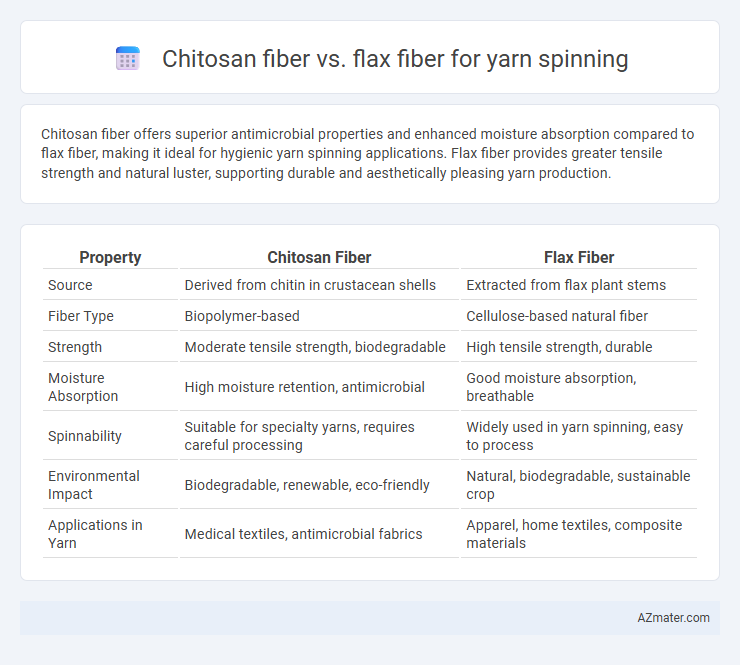Chitosan fiber offers superior antimicrobial properties and enhanced moisture absorption compared to flax fiber, making it ideal for hygienic yarn spinning applications. Flax fiber provides greater tensile strength and natural luster, supporting durable and aesthetically pleasing yarn production.
Table of Comparison
| Property | Chitosan Fiber | Flax Fiber |
|---|---|---|
| Source | Derived from chitin in crustacean shells | Extracted from flax plant stems |
| Fiber Type | Biopolymer-based | Cellulose-based natural fiber |
| Strength | Moderate tensile strength, biodegradable | High tensile strength, durable |
| Moisture Absorption | High moisture retention, antimicrobial | Good moisture absorption, breathable |
| Spinnability | Suitable for specialty yarns, requires careful processing | Widely used in yarn spinning, easy to process |
| Environmental Impact | Biodegradable, renewable, eco-friendly | Natural, biodegradable, sustainable crop |
| Applications in Yarn | Medical textiles, antimicrobial fabrics | Apparel, home textiles, composite materials |
Introduction to Chitosan and Flax Fibers
Chitosan fiber, derived from chitin found in crustacean shells, offers excellent antibacterial properties and biodegradability, making it a sustainable choice for yarn spinning. Flax fiber, obtained from the flax plant, is known for its strength, moisture-wicking ability, and natural luster, widely used in durable and breathable textiles. Both fibers present unique advantages in yarn spinning, with chitosan emphasizing biofunctionality and flax emphasizing mechanical performance.
Source and Production Processes
Chitosan fiber is derived from chitin found in crustacean shells through chemical deacetylation, involving extraction, purification, and fiber spinning via wet or electrospinning methods. Flax fiber originates from the flax plant's stem, requiring retting, scutching, and hackling to separate and refine the bast fibers before spinning. Both fibers involve natural sources but differ significantly in biological origin and extraction techniques employed for yarn production.
Chemical Structure and Composition
Chitosan fiber is derived from chitin, primarily composed of b-(1-4)-linked D-glucosamine units, featuring abundant amino groups that enhance antimicrobial properties and chemical reactivity for yarn spinning. Flax fiber consists mainly of cellulose, composed of b-(1-4)-linked D-glucose units, resulting in high crystalline structure and tensile strength ideal for durable yarn production. The chemical difference in functional groups between chitosan's amine groups and flax's hydroxyl groups significantly affects fiber reactivity, dye affinity, and biodegradability in spinning processes.
Mechanical Strength and Durability
Chitosan fiber exhibits superior mechanical strength and durability compared to flax fiber, making it a robust choice for yarn spinning applications requiring high tensile strength and resistance to wear. Chitosan fibers offer enhanced elasticity and tensile modulus, while flax fibers, though strong, are more prone to brittleness and degradation over time. The biopolymeric nature of chitosan contributes to its excellent durability under cyclic stress and moisture exposure, outperforming natural lignocellulosic flax fibers in long-term textile performance.
Moisture Absorption and Breathability
Chitosan fiber exhibits superior moisture absorption compared to flax fiber, enabling enhanced humidity control during yarn spinning and improving fabric comfort. Its natural antibacterial properties combined with high breathability make chitosan fiber ideal for producing yarns suited for activewear and medical textiles. Flax fiber, while also breathable and moisture absorbent, generally offers lower moisture retention, which can result in less effective sweat management in textile applications.
Environmental Impact and Sustainability
Chitosan fiber, derived from crustacean shells, offers superior biodegradability and natural antimicrobial properties compared to flax fiber, which is plant-based and requires significant water and pesticide inputs during cultivation. The production of chitosan fiber promotes waste valorization by utilizing seafood industry byproducts, reducing landfill burden and chemical pollution. Flax fiber, although renewable and compostable, poses higher environmental costs due to intensive farming practices, soil degradation, and potential pesticide runoff impacting surrounding ecosystems.
Biodegradability and Eco-friendliness
Chitosan fiber offers superior biodegradability due to its natural origin from chitin, decomposing faster in soil compared to flax fiber, which is derived from flax plants but involves more intensive chemical processing. Both fibers are eco-friendly alternatives to synthetic yarns, yet chitosan fiber's antimicrobial properties reduce the need for chemical treatments, minimizing environmental impact during yarn production. Flax fiber, while renewable and biodegradable, typically requires water-intensive retting, making chitosan fibers a greener choice for sustainable yarn spinning.
Yarn Spinning Performance
Chitosan fiber exhibits superior yarn spinning performance due to its excellent tensile strength, antimicrobial properties, and enhanced moisture management compared to flax fiber. Flax fiber, while biodegradable and eco-friendly, often presents challenges in spinning due to its coarse texture and lower elasticity, resulting in less uniform yarns. Chitosan fiber's compatibility with various spinning methods, including ring and rotor spinning, allows for the production of finer, stronger yarns with improved durability and reduced hairiness.
Applications in Textile Industry
Chitosan fiber exhibits excellent antimicrobial properties and biodegradability, making it ideal for medical textiles and hygiene products, while flax fiber offers superior moisture absorption and durability, favored for eco-friendly and breathable fabrics in apparel. The unique bioactive nature of chitosan enhances functionality in wound dressings and protective clothing, whereas flax's natural lignin content contributes to strength and wrinkle resistance, suited for upholstery and home textiles. Combining these fibers in yarn spinning advances sustainable textile innovation by blending antimicrobial benefits with robust mechanical performance.
Comparative Advantages and Limitations
Chitosan fiber offers excellent antimicrobial properties, biodegradability, and moisture-wicking capabilities, making it ideal for hygienic and medical textile applications, while flax fiber excels in strength, durability, and natural luster, providing superior tensile strength and breathability for conventional yarn spinning. However, chitosan fibers tend to have lower mechanical strength and higher production costs compared to flax fibers, which are more sustainable and cost-effective but lack inherent antimicrobial features. The choice between chitosan and flax fibers for yarn spinning depends on the specific performance requirements, including durability, antimicrobial activity, and environmental impact.

Infographic: Chitosan fiber vs Flax fiber for Yarn spinning
 azmater.com
azmater.com